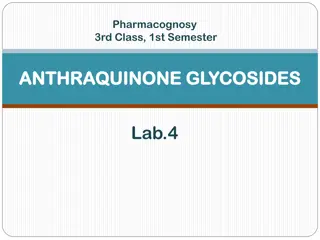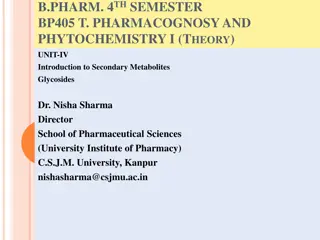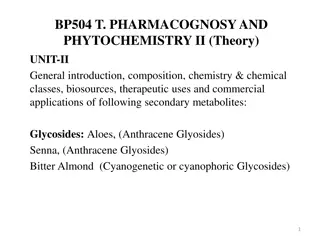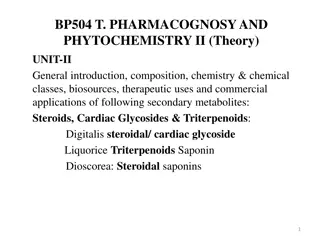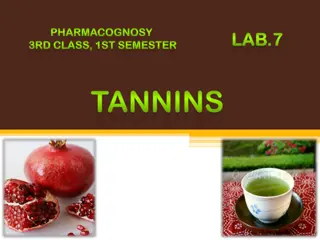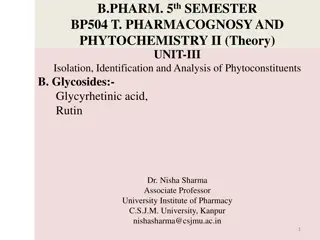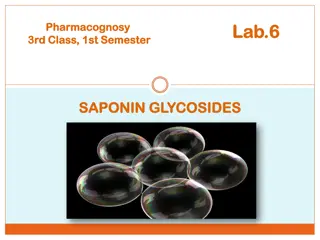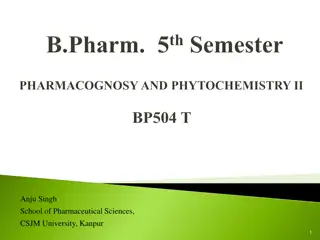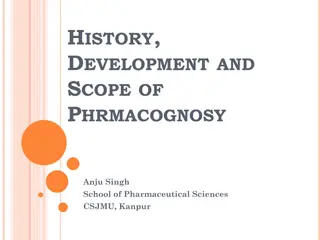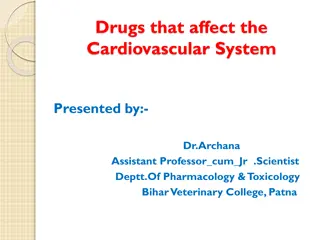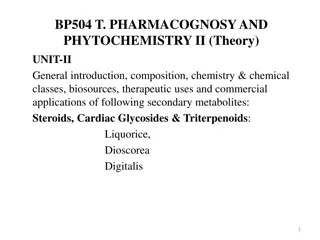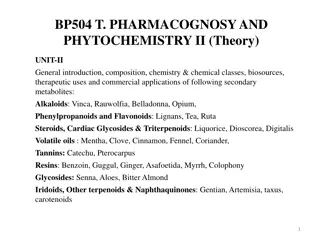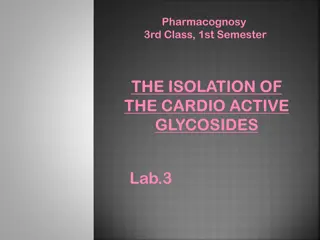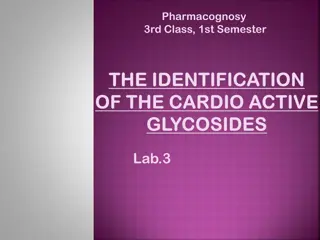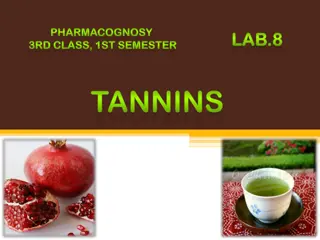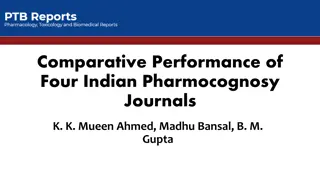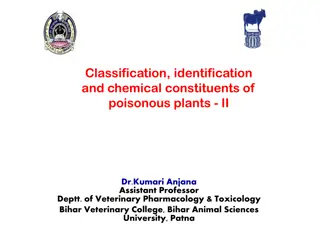Understanding Saponin Glycosides in Pharmacognosy: Properties and Applications
Saponin glycosides, found in various plants, are compounds with diverse benefits ranging from cholesterol regulation to potential anticancer properties. They form colloidal solutions in water and are used in soap manufacturing due to their unique properties. Additionally, saponins have bitter taste, can be toxic to insects, and interact with cholesterol, making them useful in controlling diseases like schistosomiasis. This article explores the properties, uses, and structures of saponin glycosides, focusing on their significance in pharmacognosy.
Download Presentation

Please find below an Image/Link to download the presentation.
The content on the website is provided AS IS for your information and personal use only. It may not be sold, licensed, or shared on other websites without obtaining consent from the author. Download presentation by click this link. If you encounter any issues during the download, it is possible that the publisher has removed the file from their server.
E N D
Presentation Transcript
Pharmacognosy Pharmacognosy 3rd Class, 1st Semester 3rd Class, 1st Semester Lab.6 Lab.6 SAPONIN GLYCOSIDES SAPONIN GLYCOSIDES
INTRODUCTION Saponin glycoside is widely distributed in plants. Saponins consist of a polycyclic aglycones attached to one or more sugar side chains. The aglycone part, which is also called sapogenin, is either steroid (C27) or a triterpene (C30) and according to the nature of the aglycone saponins are classified into Steroidal and Triterpenoidal saponins. Saponin glycosides form colloidal solution in water upon shaking, this is due to a decrease in the surface tension action of water which is done by Saponin glycosides, as a result of the hydrophobic/hydrophilic value of the Saponin (the combination of a hydrophobic (fat-soluble) sapogenin and a hydrophilic (water- soluble) sugar part) and due to this property the Saponins are used in the manufacturing of soap.
Cont Saponins bind with bile salts and cholesterol in the digestive tract, which prevents cholesterol from being reabsorbed into the body. They also react with the cholesterol rich membranes of cancer cells, preventing these cells from growing. Further protection from cancer and heart disease comes from the sapogenin component of the compound, which has antioxidant properties. The smaller amounts and types of saponins in foods we commonly eat, such as peas and beans, are safe and beneficial.
PROPERTIES OF SAPONIN Saponin has a bitter, acrid taste and drugs containing them are usually sternutatory and otherwise irritating to the mucous membrane. The most poisonous Saponin is often called sapotoxin and many are toxic to insects and mollusk and some are used to control schistosomiasis snails. Soluble in water, alcohol. Used as detergent and emulsifying agents. Cause haemolysis of RBC s when injected into the blood stream. Form complex with cholesterol. Only small part absorbed when taken orally.
Sapogenin Structure Sug-O Sug-O Steroidal Saponins Triterpenoidal Saponins
Quillaia saponaria Quillaia saponaria Quillaia bark is obtained from Quillaia saponaria Family Rosaceae which is a large evergreen with shiny, leathery leaves and a thick bark Native to China and several South American countries. The word quillay is derived from quillean that means to wash .
Quillaia saponaria Quillaia saponaria
EXTRACTION Add 0.1 gm of Quillaia bark in coarse powder to 20 ml distilled water in a beaker and boil gently for 2-3 minutes filter hot and allow cooling.
Cont A. Dilute 5ml of the filtrate with water and shake vigorously. B. a) Add to the remained of the filtrate 5ml of dilute H2SO4 b)Boil gently for 3-5 minutes or until precipitate is formed. c)The aglycones are obtained by acid hydrolysis and are insoluble in water but are soluble in 90% alcohol. d)Make the filtrate alkaline by adding NaOH, and then carry the first chemical test which is :-
CHEMICAL TESTS 1) THE FEHLING TEST Principle: Principle: Redox reaction, reducing property of sugars. Result Result: : Brick- red precipitation in the solution and this indicates the reduction of Copper ions in an alkaline solution by the reducing monosaccharide or sugars as glucose.
Discussion The addition of H2SO4 and boiling lead to hydrolysis of the glycoside to aglycone and glycone, and the aglycone will be precipitated since it is insoluble in water. The alkalization with NaOH is necessary for the action of the Fehling reagent, which indicates the presence of the sugar part, and red precipitate appears.
2) 2)HAEMOLYTIC TEST HAEMOLYTIC TEST Aim Aim Identity test (specific) for Saponin glycosides. Equipment and reagents Equipment and reagents a) Two test tubes b) 10% solution of blood c) Normal saline Procedure Procedure 1) Take two test tubes 2) Place in each 5ml of a 10% solution of blood in normal saline. 3) Add to the one of them 5ml of normal saline solution and to the other one add 5ml of the extract of Quillaia prepared by shaking powdered Quillaia bark with normal saline solution , and filtering clear. 4) Shake both tubes gently and notice the results. Results Results The test tube containing the 5ml of the extract of Quillaia will cause blood hemolysis .
3) 3)FOAM INDEX FOAM INDEX Foam index is a value which is used to express the quality of the crude drug containing Saponins . The method is based upon the property of Saponin to form foam when shaken with water and this ability to foam is caused by the combination on non-polar sapogenin and water soluble side chain. The foam index signifies the dilution of the substance or drug to be tested which gives a layer of foam 1 cm high if the aqueous solution is shaken for 15 seconds, and then allowed to stand for 15 minutes before reading is made.
Cont Aim Aim Identity test (specific) for Saponin glycosides. Equipment and reagents Equipment and reagents a) 10 test tubes have the same diameter. b) Graduated pipette c) 0.1% decoction from the powdered drug. d) 1% solution of sodium carbonate
Cont Procedure Procedure 1) Prepare 0.1 %decoction from the powdered drug neutralize it by adding 1% solution of sodium carbonate drop and filter. Into 10 test tubes having the same diameter, 1 to 10ml of the decoction respectively is added using a graduated pipette, complete to 10 ml with water, shake the content of each test tube thoroughly for 15 second and allow standing for 15 minutes. 2) After this time , the reading is made in the test tube containing the most dilute solution a ring of foam 1cm high is formed. When this is for example in the test tube number 8, which contains 8ml of the decoction and 2ml of water, then 8ml of 0.1% decoction corresponds to 0.008 gm of the drug and the dilution is calculated from the following equation. 3)
Cont 0.008/10 =1/x X=10/0.008 X= 1250 That means the ring of foam 1cm high is formed by a solution diluted 1:1250 The foam index is therefore 1250 Note Note The addition of sodium carbonate is to convert the acidic Saponin that may be present in the decoction to salts which are soluble in water.




